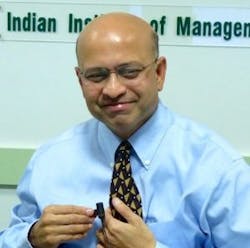Mahesh Bhave, of BHAVE Power Systems, says that the entire world stands to benefit as Puerto Rico gives full policy attention to microgrids and confronts fundamental questions about electricity policy.
Mahesh Bhave
The Puerto Rico Energy Commission deserves praise for raising the right and important questions about the future of electricity on the island, and in particular about the role for microgrids, in the wake of Hurricane Maria.
The commission regulates PREPA, the Puerto Rico Electric Power Authority, a government-owned power company, responsible for electricity generation, transmission, and distribution.
The questions were published in a Report and Order on November 10, signed by Jose Roman Morales, interim chairman, and Ángel Rivera de la Cruz, both associate commissioners of Puerto Rico’s Energy Commission. The commission sought public comments on the questions by November 20.
In the interim, on November 14, the who’s-who responsible for Puerto Rico’s electricity from Governor Ricardo Rosselló to the leadership of PREPA participated in the Senate hearings chaired by Alaska Sen. Lisa Murkowski of the Senate Energy and Natural Resources Committee. The hearings, riveting to watch, lasted for over three hours.
Questions all regulatory commissions should ask
So fundamental – and historic – are the questions in the report and order that I believe all public utility commissions should address them for their respective state jurisdictions.
In the wake of wholesale destruction of Puerto Rico’s electricity infrastructure, hurricane Maria has raised the very basic questions: If we start from scratch, and given the technical options available today, how would we build the electricity infrastructure of the future? Would it be a “federation of microgrids”? Who should own it, what regulations should enable it, what is the role for the incumbent operator, what is the role of the regulatory commission? Is the technology ready? What might be the attributes of the microgrids we deploy?
Of course, the solution should survive the inevitable future storms. To the extent Puerto Rico answers these questions well, it is poised to become a global leader in next generation electricity. I have re-organized and summarized the commission’s questions below.
Role of the PR energy commission?
- What legal authority does the commission have to promote microgrids?
- In the age of microgrids, what should the role of any regulatory commission be, given that microgrids signal the end of “natural monopoly,” create low “barriers to entry,” and as a result, competitive markets?
- Should the commission encourage new market entry? How?
- Should the regulatory commission license or set financial criteria for microgrid licenses? Inspect microgrids when deployed? Define microgrid safety standards?
- Should the commission price microgrid electricity?
Role for PREPA, and by extension for investor-owned utilities?
- Should PREPA’s role as a government-owned, monopoly utility end?
- Should PREPA deploy microgrids? Should PREPA be excluded from microgrids?
- Can generating assets contracted to PREPA be repurposed for microgrid use?
Attributes of microgrids?
- Do the microgrids link with PREPA? Or to each other?
The commission deserves credit for raising this important inter-microgrid connectivity issue because there is so little work done on the subject, as I have argued in my book.
- Should microgrids be “behind the meter,” owned by customers? More generally, who should be the owners and customers of microgrids?
- How is microgrid electricity priced? Should it be in $/kWh?
Clearly, electricity pricing needs reform in the age of distributed resources and microgrids. In raising this issue, the commission entertains the possibility of alternate pricing, for example, by services delivered, say, illumination, heating, refrigeration, cooling, … or flat-rate pricing, like gigabyte bundles in internet access, and not merely $/kWh as is historical practice.
- Where should microgrids be ideally located, or placed? What are the sizes of microgrids?
This raises the possibility of an office building or a hospital, or a neighborhood or shopping mall as a microgrid. Their sizes will vary, yet they can inter-work among themselves, and not only “talk” with the PREPA grid.
The commission has also raised operational issues: How are microgrids financed? By whom? Does the commission qualify a microgrid developer? Can customers opt out of microgrids?
Puerto Rico tackles a brave new world, head on
Microgrids advance in the continental US is slow, mired in existing regulatory context, beholden to the monopoly power of investor owned utilities (IOUs), and deals with technical minutiae of reliability and resilience. Microgrids get lip-service, a token acknowledgement, but not the full policy attention they deserve. This is true even in the so-called progressive states, California, Illinois, and New York. The few microgrids that have been deployed get repeated mention. No one has undertaken what is necessary – addressing Industry Structure Change – market competition for monopoly utilities, customer choice, new player entry, new customer offerings resulting from advances in distributed renewables and storage.
In this context, forced by hurricane Maria, Puerto Rico faces fundamental choices, and appears ready to confront them with an open mind. The entire world stands to benefit, with clean electricity and climate change mitigation as the outcome, depending on what Puerto Rico achieves.
Mahesh Bhave is founder of BHAVE Power Systems. He is the author of The Microgrid Revolution: Business Strategies for Next Generation Electricity.







